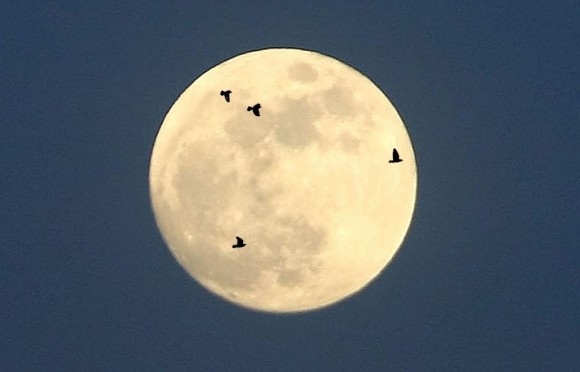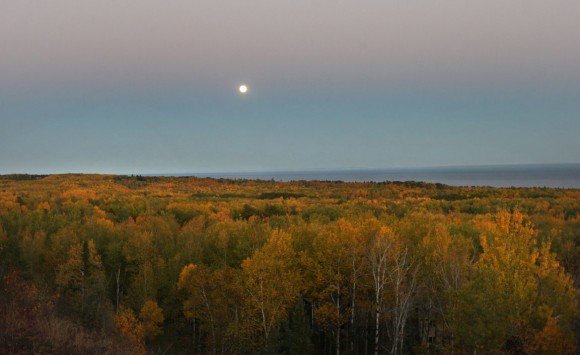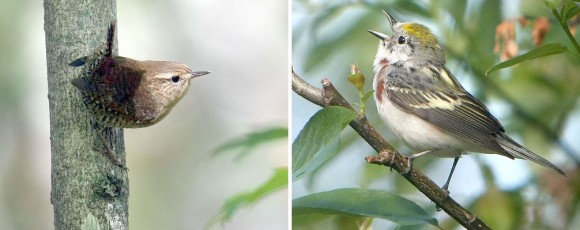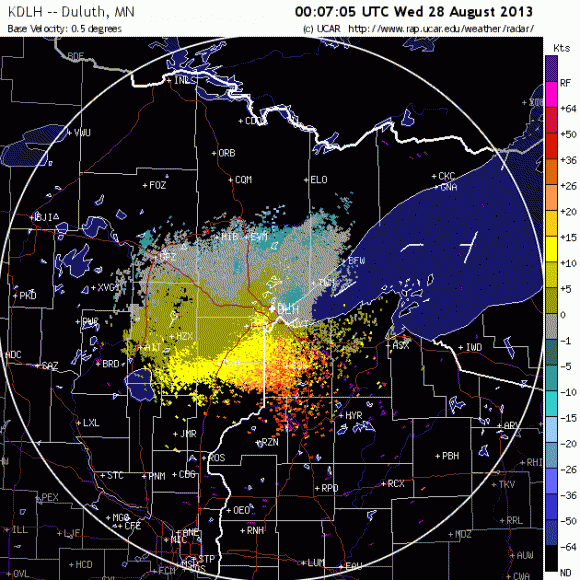

| Visitors Now: | |
| Total Visits: | |
| Total Stories: |

| Story Views | |
| Now: | |
| Last Hour: | |
| Last 24 Hours: | |
| Total: | |
Tonight’s Harvest Moon Is For The Birds … Really!

The full moon provides the perfect backdrop for watching birds migrate at night. Observers with spotting scopes and small telescopes can watch the show anytime the moon is at or near full. Photo illustration: Bob King
Tonight’s the Harvest Moon, the full Moon closest to the fall equinox. A perfect time to catch a big orange Moon on the horizon AND the annual fall bird migration. Every September and October anyone with a small telescope or spotting scope magnifying 30x can enjoy the sight of one bird after another flying over the cratered lunar landscape. It’s so easy.
Point your telescope at the Moon and watch for dark silhouettes to flutter across its face. Because the angle of the full Moon’s path to the horizon is very shallow in September and October, the time difference between successive moonrises is only about 20-30 minutes instead of the usual 50-60. That means you’ll catch both moonlight and bird flight on successive nights without having to stay up late.

The Harvest Moon rises over Lake Superior in Duluth, Minn last September. When you’re out moon and birdwatching, look for the dark band below the rising moon. That’s the Earth’s shadow. It’s visible for about 15-20 after sunset and topped by the pink-tinged “Belt of Venus”, where the atmosphere is still reflecting reddened sunlight. Credit: Bob King
Many birds migrate at night both because it’s cooler and to avoid predators that could otherwise pick them off in a daylight run. Identifying the many warblers, blackbirds, sparrows, vireos, orioles and other species that fly across the moon while we sleep may be next to impossible for anyone but an expert, but seeing them is easy. Two night ago for fun, I counted a dozen birds in the five-minute interval around 10 o’clock through my 10-inch telescope at low power (76x). Assuming they continued to fly by at a steady rate, I could potentially have spotted 144 birds in just an hour’s time.

Two of my favorite migrating birds: the winter wren (left) and chestnut-sided warbler. Credit: Bob King
As you might suspect, most of those birds crossed the Moon from north to south (about two-thirds) with the other third traveling either east to west or northeast to southwest. Only one little silhouette flapped back up north in the ‘wrong’ direction.
According to the Chipper Woods Bird Observatory, located in Indianapolis, most nighttime migrators begin their flight right after sunset and and continue until about 2 a.m. Peak time is between 11 p.m. and and 1 a.m. Bird typically migrate at altitudes ranging from 1,500 to 5,000 feet, but on some nights, altitudes may range from 6,000 and 9,000 feet. I could tell the high ones from the low ones by their size and sharpness. Nearby birds flew by out of focus, while distant ones were sharply defined and took longer to cross the moon.

Check out this animation showing a wave of bird migration after sunset on Aug. 27 made with NEXRAD. Birds are visible funneling down both shores of Lake Superior and moving south of Duluth, Minn (city at center). Credit: NWS
While birders may continue to use the moon night birding, they now have a new tool – NEXRAD or NEXt-generation of Weather RADar. About 150 NEXRAD sites were set up in the 1990s to track weather and storm systems across the U.S. When precipitation gets pinged by the radar’s pulse it reflects back a signal that identifies it as rain, snow or whatever. Included in the information is the material’s speed and direction of travel. NEXRAD works equally well on meteorite falls, birds and even insects. While storm activity typically shows up as familiar blotches of yellow, orange and red, birds appear as fine stipplings. By compiling NEXRAD loops, during particularly heavy migration times, you can actually watch swarms of birds wing their way south. Click HERE for a map of all U.S. NEXRAD locations, each of which links to current radar maps.
On the less technological side, watching birds pass across the Moon in a small telescope is a very pleasant activity reminiscent of meteor shower watching. At first you see nothing, then blip! a bird (meteor) flies by. You wait another minute and then suddenly two more appear in tandem. Both activities give you that delicious sense of anticipation of what the next moment might hold.
The best time to watch the nighttime avian exodus is around full Moon, when the big, round disk offers an ideal spotlight on the birds’ behavior, but anytime between waxing and waning gibbous phase will work. It’s an enchanting sight to see Earth’s creatures streak across an alien landscape, and another instance of how a distant celestial body “touches” Earth in unexpected ways.
© Bob King for Universe Today, 2013. |
Permalink |
No comment |
Post tags: bird, full moon, harvest moon, migration, NEXRAD, radar
Feed enhanced by Better Feed from Ozh
Source: http://www.universetoday.com/104824/tonights-harvest-moon-is-for-the-birds-really/


